When someone asks the question “What is the ‘best’ 35mm rangefinder ever made?”, a great number of responses will likely include either the Leica M3 or the Nikon SP. The reason for these two models on the tops of so many people’s lists is that they are both very good cameras, made by two very good companies, at a period of tremendous innovation in the industry.
The Leica M3 and Nikon SP aren’t just two cameras that collectors today like to compare, they also competed against each other in the 1950s when each was released. The Leica M3 came first, beating out the Nikon S2 which was the model before the SP, so you could say the SP had a bit of an advantage as Nippon Kogaku was able to see what they were up against, whereas Leitz’s release of the M3 came unexpectedly and without any real competition to compare themselves to.
As I type this, I am well aware of the immense popularity of both of these models, along with the huge number of people who strongly love one model over another, and I am certain at least a few people won’t make it to the end of this Showdown without repeatedly stabbing their Mike Eckman voodoo doll™!
I’ll also give the disclaimer that I consider myself a fan of both cameras. Holding and shooting either a Leica M3 or Nikon SP is an amazing experience. Both cameras are worthy of their inclusion at the top of many people’s lists because quite simply, they both deserve it. But this is the Internet, where people love making lists and insist there must be a best of everything, so here’s my best attempt to determine the best 35mm rangefinder comparing the two best options I could think of. That’s a lot of bests!
Looking at the specs, it is clear the two cameras were meant to compete with each other, which is exactly why this showdown is being done in the first place. But of course, two cameras that look very similar on paper may not always come out so close in use.
Lens Selection
Of all the categories in this showdown, lens selection is probably the easiest one to score in favor of the Leica M3 as the mount is still used today and new lenses are still being made for it. The Nikon S-mount, which is almost identical to the original Zeiss-Ikon Contax mount, has not seen a new lens made in quite some time. Furthermore, M39 screw mount lenses can be used perfectly with a Leica M adapter without sacrificing any functionality on the M3, further adding to the selection available.
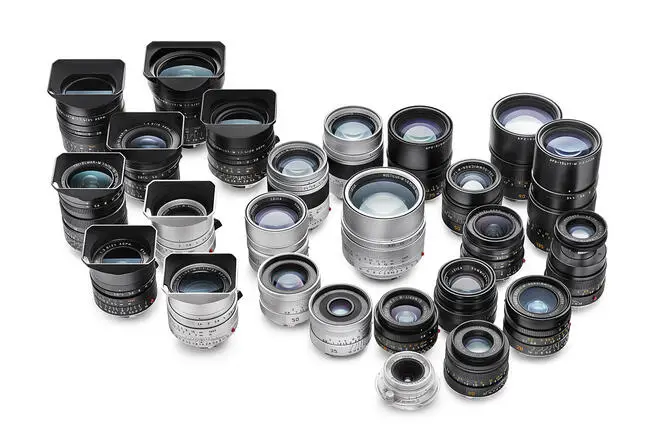
I’m being very careful here not to suggest that M-mount lenses are superior to Nikon lenses, as over 100 years of history proves that Nikon (then Nippon Kogaku) was an excellent lens maker. I might even agree that in specific periods in the past, Nikkor lenses were superior to anything you could mount to the M3, but again, that’s not what I’m judging here. In terms of pure selection, there are simply far more options for the M3 than the SP, so the M3 is the clear winner here.
Winner: Leica M3
Features
If all a camera needed to have was a shutter, lens, and viewfinder, there likely wouldn’t have been such a huge variety of them released over the past 150 years, but beyond the basics, people looking to buy a camera spend their money on something that has the complete package of everything that they want. A long list of well thought out features are going to make the decision to purchase one model over another much easier.
When both the Leica M3 and Nikon SP were new models, the sales people working in camera shops would have had to know which features each had, and try to find the one that fits the needs of each customer better. If someone wasn’t yet convinced at the quality of a Japanese made camera, going for the M3 was the logical choice, if cost was a concern, the Nikon was the more economical choice, but for everyone else, the features of each camera likely helped them make their decision.
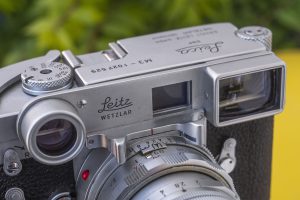
In terms of what’s necessary to take photos, both the Leica M3 and Nikon SP compare favorably. There isn’t one major feature that one has that the other doesn’t, but there are some differences. For the Leica, a large and bright viewfinder with an extremely accurate rangefinder patch, and the ability to close focus down to 21 inches with the optional “dual-range” Summicron would have been tremendous selling points. Compared to other cameras when it was first released, having a door on the back of the camera to inspect the film compartment while loading film was a big improvement over the earlier screw mount Leicas, as was the film advance lever and single shutter speed dial with every speed on it.
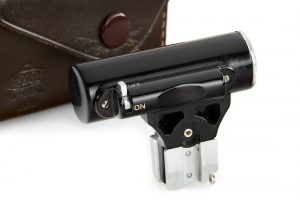
The Nikon SP had the benefit of coming nearly 3 years after the M3, but when it did, it matched the M3 in all of those areas, but improved upon them by having an entirely removable back, something that for many people made film loading easier but also allowed for optional bulk film backs, something the Leica didn’t. Later versions of the SP had a Titanium foil shutter which was impervious to pinholes in a cloth shutter from the lens being exposed to direct sunlight. The Nikon SP also had a dual viewfinder system with up to 6 focal lengths represented from 28mm all the way to 135mm without the need for an auxiliary viewfinder.
With the M3, if you wanted to shoot anything wider than 50mm, you either had to trade in your M3 for an M2, use an auxiliary viewfinder, or in the case of the Leitz Summaron 35mm lens, use a set of auxiliary goggles that go in front of the viewfinder window to alter it’s focal length.
The Nikon SP also supported an external motor drive which allowed for up to 3 exposures per second, something that professional photographers would have definitely found useful. The M3 was never offered with any sort of factory motor drives, although some third party modifications can be made to give it this capability. Finally, the SP had a gimmicky, but neat illuminated viewfinder attachment that when clipped to a small post in front of the accessory shoe on the top of the camera, would illuminate the viewfinder frame lines and rangefinder patch in complete darkness. It wasn’t necessary, but it gave the camera a “gee-wiz” feature that the Leica lacked.
When looking at pure features, excluding the Nikon SP’s illuminated viewfinder accessory, all of the additional features for that camera make it a better camera, and if a motor drive or bulk film back is something you needed, the SP is the definite winner here.
Winner: Nikon SP
Viewfinder
Although I mention the viewfinder as a feature above, the viewfinder is such a critical part of what can make or break a camera, I think it’s deserving of it’s own section.
Before getting into the differences between the viewfinders on both cameras, I should point out both the Leica M3 and Nikon SP have two of the best viewfinders on any rangefinder camera ever made. Both are deserving of praise as there really is no loser in this category, but there are differences.
Nippon Kogaku’s marketing material is quick to point out the Nikon SP’s two viewfinders offer six different frame lines for lenses from 28mm to 135mm, but for anyone who hasn’t ever handled one before, you may not realize that the second viewfinder showing a full 35mm image with 28mm non-parallax corrected framelines, is separate from the rangefinder and quite a bit smaller. It’s essentially like having a shrunken down auxiliary wide angle viewfinder integrated into the body. It certainly works, but is a far cry from the gloriously large wide angle Leitz or Canon viewfinders.
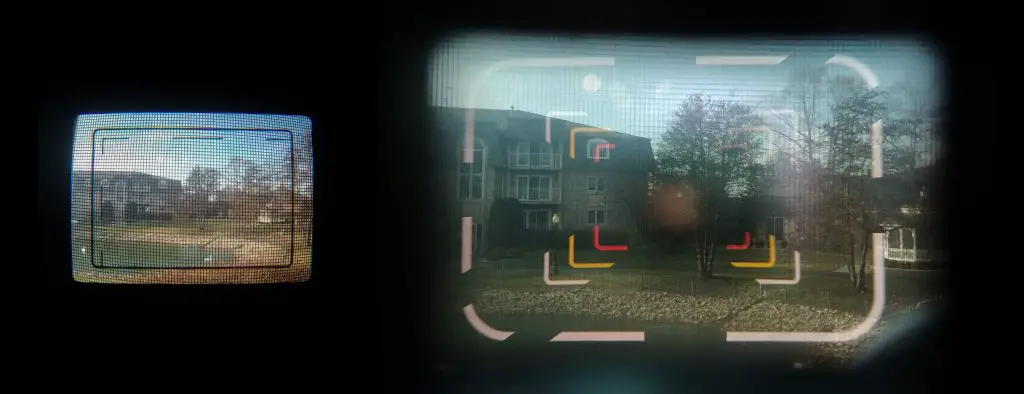
The Leica is limited to only three frame lines, 50mm, 90mm, and 135mm, but in the case of the two telephoto lengths, the camera automatically detects which focal length to use and adds in the appropriate frame lines in the viewfinder. The Nikon SP lacks any ability to detect focal length and requires you to manually set the length using a dial on the top plate.
Frame lines aside, comparing the rangefinder patch of the two cameras, the Leica M3’s is quite a bit larger. An unscientific estimation looking at both cameras side by side, I’d say the Leica M3’s patch is not only twice as large, but is also one of the largest rangefinder patches on any 35mm rangefinder I’ve ever used.
As a person with poor vision where a good viewfinder is essential to using a camera effectively, I prefer the one in the Leica M3. To some, the lack of any wide angle frame lines might be a con, but I’d wager that the majority of people shooting wide angle lenses on a rangefinder camera are already used to using an auxiliary viewfinder, plus using a dedicated wide angle viewfinder is both much larger and more pleasant to use than the tiny secondary wide angle viewfinder in the SP.
For me, this one’s not even close. The Leica M3 has a better overall viewfinder than the SP, but if it sounds like I’m dogging on Nippon Kogaku’s premiere rangefinder, I must repeat that the SP is also very good too. It’s just that in a head to head comparison against what I consider to be the best ever made, the Leica M3’s viewfinder wins.
Winner: Leica M3
Ergonomics
The design and layout of a camera’s controls is a largely subjective thing to rate as what is comfortable to one user might be different to another. The tactile feel of a knob or dial likely won’t have any impact on the usability of a camera, but still might evoke an opinion one way or another to one person that another doesn’t agree with.
With that in mind, I’ll start off with a generic statement that neither the Leica M3 or Nikon SP have any poorly located controls or strange ergonomics. Every single control on both cameras is exactly where you expect it to be, and for the first time user, likely would not require any sort of tutorial in how to use the camera.
In terms of size, both cameras are pretty close in every dimension. The Leica is about 2mm wider, a hair thicker, and maybe 1mm shorter. Remove the lenses, and the weight of the two bodies are within 2 grams of each other, making both cameras equally stressful on your neck while out shooting.
The difference here is going to come down to two very minor differences. The first is that for my hand size, the rounded edges of the M3’s body are slightly more comfortable to hold, and the location of the Leica’s shutter release button is more forward on the top plate which is not only in a more comfortable location for my finger, but also allows for a more secure grip of the camera.
In the two images above, I asked my wife to hold both cameras without any instruction from me. All I asked her to do was hold them in whatever way felt the most comfortable to her. Notice how with the Leica, her middle, ring, and pinky fingers are securely wrapped around the front of the camera and her index finger rests on the shutter release more to the side.
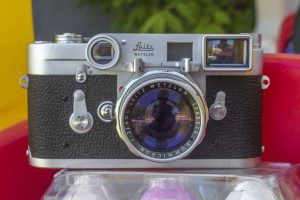
With the Nikon, the shutter release’s location is closer to the back of the camera, requiring her to hold her hand farther back with her index finger coming more from the rear of the camera. The more backward location of her hand, means that her other three fingers aren’t able to wrap around the front of the camera as much, resulting in a less secure grip. I could have asked her to keep her hand more forward to allow for a tighter grip on the camera, but this would have required she contort her index finger at a rearward angle, to reach the location of the shutter release.
Comparing how she instinctively holds the camera compared to how I do, the locations of my fingers are almost the same. I have longer fingers, so I can wrap them around the front of the Nikon a little better, but my longer fingers also require a more contorted angle to reach the shutter release. On the Leica, it just feels more natural.
With the rest of the camera’s use largely the same, it all comes down to body shape and the location of the shutter release, and for me, the M3 gets it more right.
Winner: Leica M3
Reliability
In some of my previous Showdown articles, I’ve put cameras head to head that have pretty significant differences in reliability. For example, the Pentax K1000’s fully mechanical build has proven to stand up to the perils of time much better than the electronics in the Canon AE-1, but in this comparison, you’re talking about two of the best cameras ever to come out of Germany and Japan.
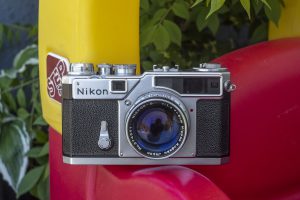
Both Leitz and Nippon Kogaku ascended to the top of the camera making world, not because some Kardashian hawked their camera in a TikTok video, but because they tirelessly committed to excellence in every facet of each camera’s design, construction, and testing.
Quite simply, the Leica M3 and Nikon SP are two of the best cameras ever made, but even the best of the best are not immune to father time as both cameras used for this review had a couple of issues. For the Leica, it’s shutter speeds are clearly out of adjustment as the curtains don’t separate at 1000 and 500. The slower speeds work OK, but I don’t trust the 1 second setting either. The Nikon’s shutter seems to have held up better, but the viewfinder has some pretty significant haze making it pretty difficult to see through.
Of course, no camera, even the best ones, were meant to last forever without any service, but I believe that with some TLC and a CLA, both the SP and M3 could be AOK! I don’t think there’s enough of a measurable difference here to declare one as more reliable than the other, so this one’s a tie. My only disclaimer is, that if you are prepared to spend the money to buy either of these cameras, you should also be prepared to get them serviced too.
Winner: Tie
Performance
I don’t know why I even bother to bring up the performance of either camera as you’re comparing a Nikon and a Leica rangefinder that are both highly regarded for their ability to make great images. Each of these cameras have been good enough for countless amateur, semi-pro, and professional photographers for greater than half a century, so they’re certainly good enough for you.
This ones a tie…duuuh!
Winner: Tie
Price / Value
In order to fairly compare two cameras on price, I think you need to take into account both the price at which the camera originally sold, and what you can get them for now. In my showdown for the Pentax K1000 and Canon AE-1, I noted that when each model originally went on sale, the K1000 was much cheaper than the AE-1 and that it wasn’t until decades later that the two cameras began to be recommended head to head as good student cameras.
This isn’t the case with the Leica M3 and Nikon SP as the two cameras have always been marketed head to head as direct competitors. Looking at the 1960 catalog from Olden Camera in New York City who sold both cameras new, the price of a Leica M3 with the 50mm f/1.4 Summilux, 50mm f/2 Summicron, and M3 body only were $468, $399 and $270 respectively.
In the same catalog, the Nikon SP with Nikkor 50mm f/1.4 and Nikkor 50mm f/2 (a body only price is not listed) were $375 and $329.50 representing roughly a 20% discount for the Nikon.
Looking at prices today is a bit more difficult because condition varies tremendously, plus if you just look for eBay sales of the Nikon SP, you’ll find a number of the 2005 Special Edition which go for dramatically more and aren’t reflective of an original SP, so I won’t count those.
For a modern day price comparison, I searched sold eBay listings for both the Leica M3 and Nikon SP body only and with a 50mm lens. I eliminated any that were listed as in Parts condition or were in obviously poor condition. I also eliminated any that came with extra lenses, rare lenses, original packaging, had black bodies, or anything that would boost the overall lot of either camera. My intent was to find a middle ground version of both cameras in a similar user condition to the two I had available to me in this review.
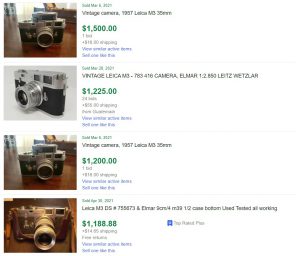 There were 153 Leica M3s that matched my criteria, of which body only Leica M3s in user condition seem to start around $1100 and go up to about $2100 in tested condition with a lens. Outliers in this range were up to $2550 for a really nice single stroke model with 50mm Summicron, and $350 for a really horrible looking body. I found both double stroke and single stroke models in this range and although there were a lot more double strokes to choose from, the single strokes seem to be on the higher end of the price scale.
There were 153 Leica M3s that matched my criteria, of which body only Leica M3s in user condition seem to start around $1100 and go up to about $2100 in tested condition with a lens. Outliers in this range were up to $2550 for a really nice single stroke model with 50mm Summicron, and $350 for a really horrible looking body. I found both double stroke and single stroke models in this range and although there were a lot more double strokes to choose from, the single strokes seem to be on the higher end of the price scale.
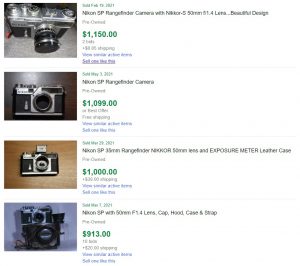 Using the same criteria as above, there were only 34 sold Nikon SPs to choose from. The much smaller number is consistent with how many fewer SPs were sold than the Leica M3, so this difference is not surprising. User condition bodies start at around $700 and went up to $1600 with a lens. Outliers in this range was a Japanese “MINT++++” example for $1818 and a parts only body that really didn’t look that bad for $405.
Using the same criteria as above, there were only 34 sold Nikon SPs to choose from. The much smaller number is consistent with how many fewer SPs were sold than the Leica M3, so this difference is not surprising. User condition bodies start at around $700 and went up to $1600 with a lens. Outliers in this range was a Japanese “MINT++++” example for $1818 and a parts only body that really didn’t look that bad for $405.
There is an obvious risk with buying any used half century old camera, especially those not guaranteed to work, but despite their rarity, I feel confident in saying you will spend less money to get a nice Nikon SP than a Leica M3.
Taking into account that the Nikon SP has always sold at a discount ever since it was first released, and that now it’s still a more affordable option, it’s pretty clear that the Nikon SP is the value leader between the two.
Winner: Nikon SP
Final Conclusion
There’s always a certain expectation of ruffling someone’s feathers when you put two very popular cameras head to head, which is why I don’t do these Showdown articles that often. In the case of the Leica M3 and Nikon SP, I am well aware of how many fans both cameras have.
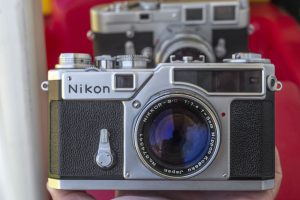 If I’m being perfectly honest, based solely on pure emotion, I have always been and probably always will be a Nikon guy. Both my first film SLR and DSLRs were Nikons. I consider the Nikon S2 to be one of my all time favorite cameras and the N90s is a camera I regularly mention as the best value film SLR ever made. I love the history of both Nikon cameras and Nikon the company. For the longest time, I never sought out to own a Leica M3 because so many people raved about them, I grew a little tired of all the hype.
If I’m being perfectly honest, based solely on pure emotion, I have always been and probably always will be a Nikon guy. Both my first film SLR and DSLRs were Nikons. I consider the Nikon S2 to be one of my all time favorite cameras and the N90s is a camera I regularly mention as the best value film SLR ever made. I love the history of both Nikon cameras and Nikon the company. For the longest time, I never sought out to own a Leica M3 because so many people raved about them, I grew a little tired of all the hype.
The reality is, both of these cameras are well built, both have a large availability of some of the best lenses ever made, both are historically significant, and both are excellent examples of the “Golden Era” of both the German and Japanese photo industries.
That said, if I had to make a recommendation of one over the other, I’m going to have to go with the Leica M3. Sure, it’s a bottom loader, it doesn’t support a motor drive or bulk film backs, and it doesn’t have built in frame lines for any lenses wider than 50mm, but the things it lacks aren’t things that matter to me and the whole bottom loader panic gets blown out of proportion quite a bit. If there were both back loading and bottom loading M3s, sure, I’d choose the back loading one, but the fact that I can see the whole film compartment when loading the SP doesn’t automatically make it a better camera.
The Leica has a much better viewfinder for all the lenses I’d use it for, it is more comfortable for me to hold, it has a larger selection of lenses, and although the Nikon equals it in this regard, it has an incredible build quality that’s as good as anything ever made.
Both when the Nikon SP was new and today, it can be had for less money, but for most people, even at a lower price, a nice Nikon SP is still quite an investment, and whatever savings you might have going with one isn’t enough for me to pick it over the Leica.
What do you think about my recommendation? Do you agree or disagree? Let me know in the comments section below.
External Resources
I’ve written full reviews of both the Leica M3 and Nikon SP which can be found below, but don’t take my word for it, check out one of these other excellent reviews for both cameras.
Leica M3
https://www.35mmc.com/02/02/2015/leica-m3-review/
https://www.photothinking.com/2020-05-15-leica-m3-double-stroke-of-genius/
https://www.kenrockwell.com/leica/m3.htm
https://www.anatomyfilms.com/leica-m3-still-greatest/
Nikon SP
https://www.kenrockwell.com/nikon/rangefinder/sp.htm
https://www.cameraquest.com/nikonsp.htm
http://leicaphilia.com/tag/nikon-sp/
https://casualphotophile.com/2018/09/07/nikon-sp-limited-edition-overview/

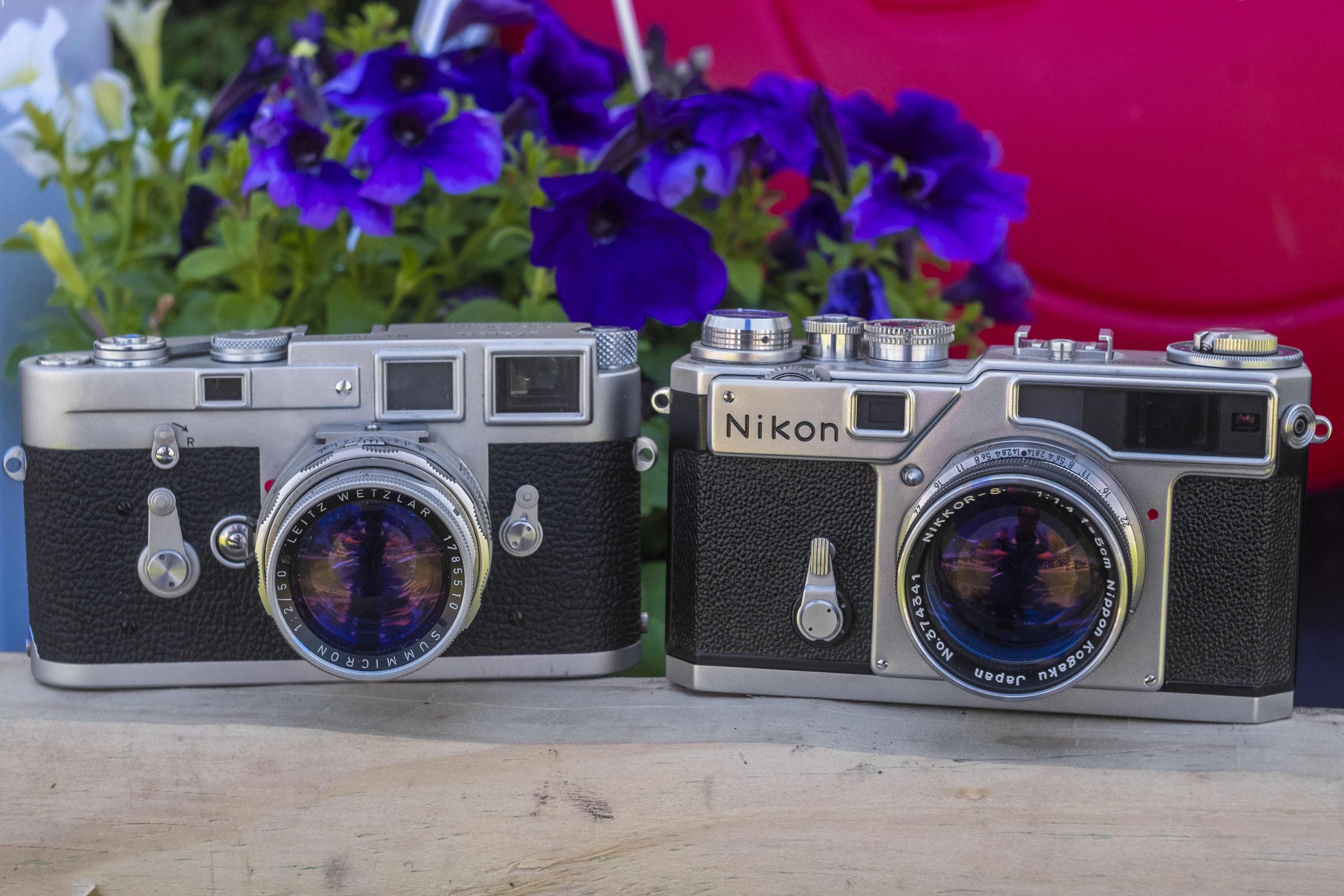
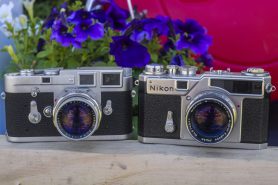
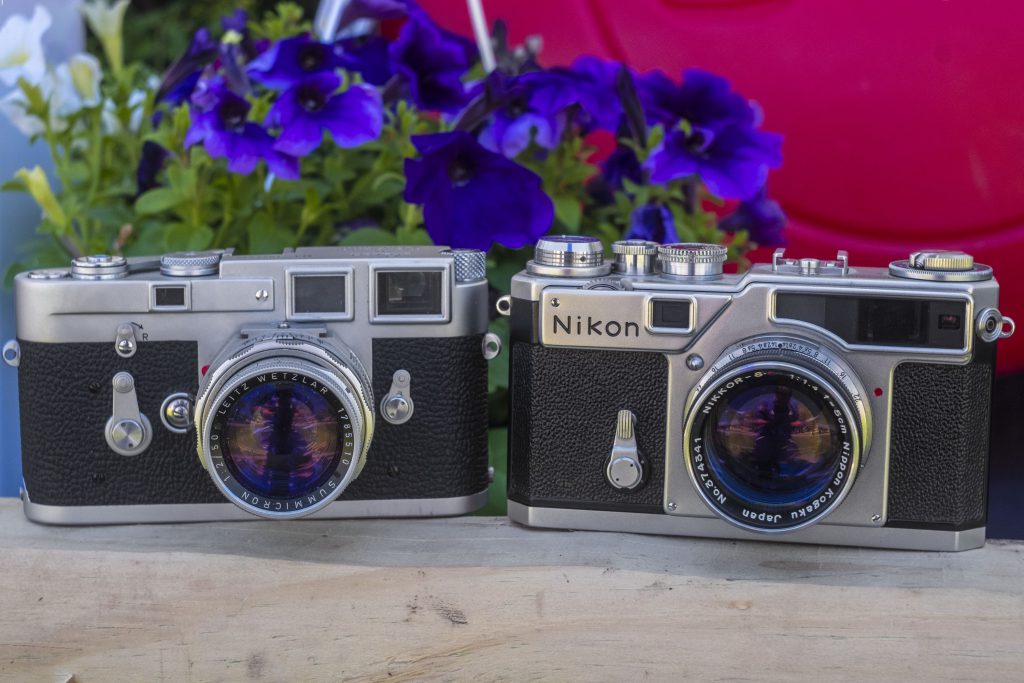
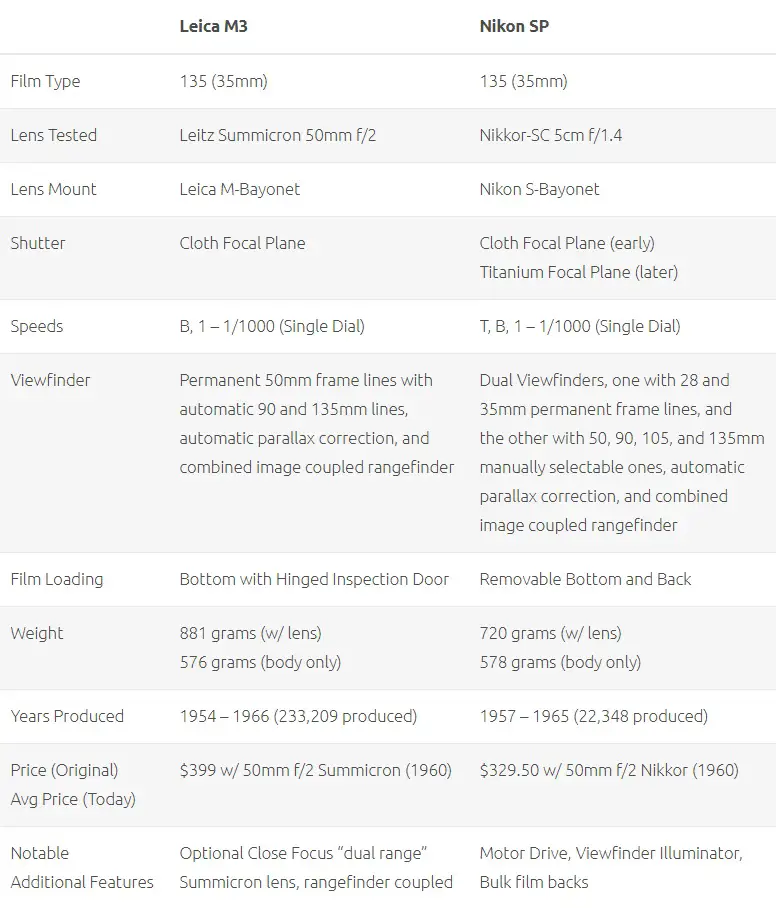
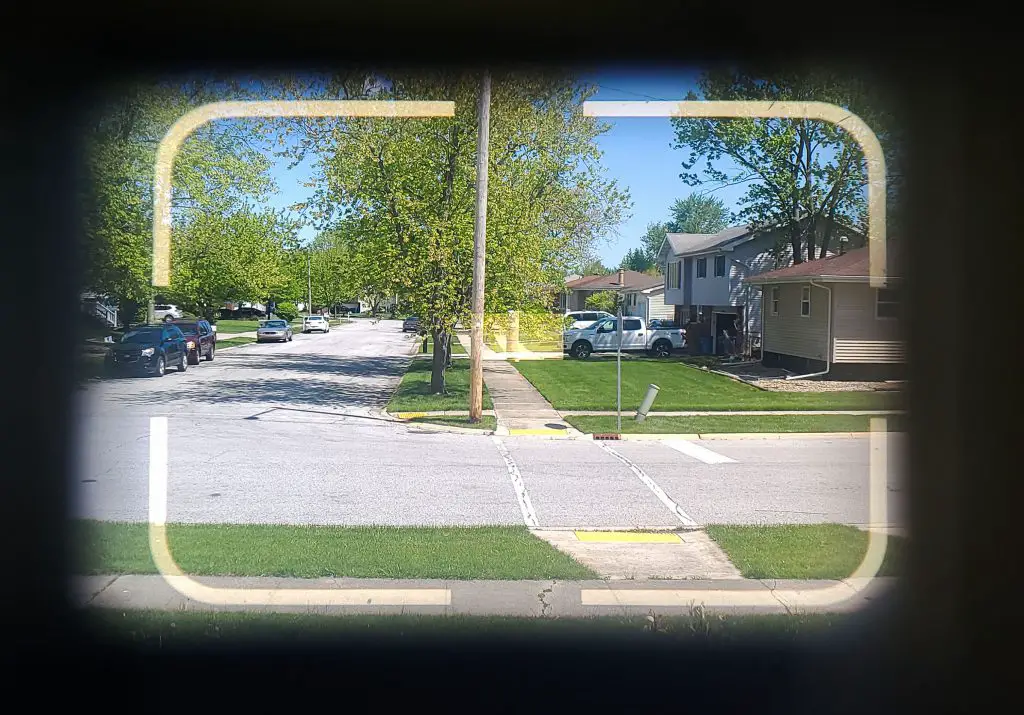
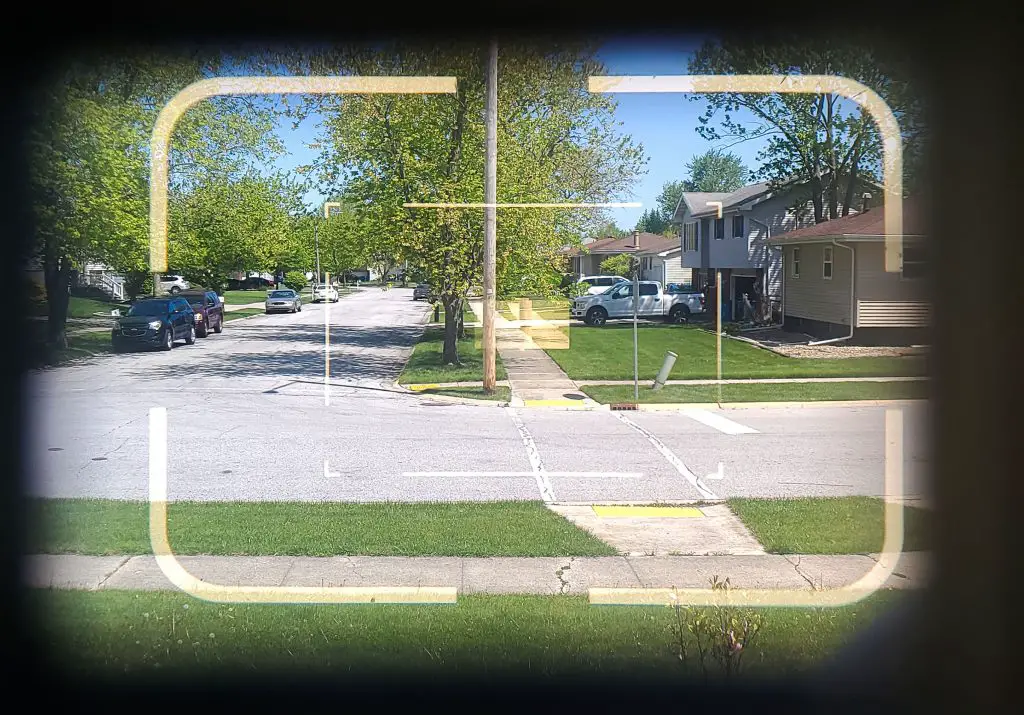
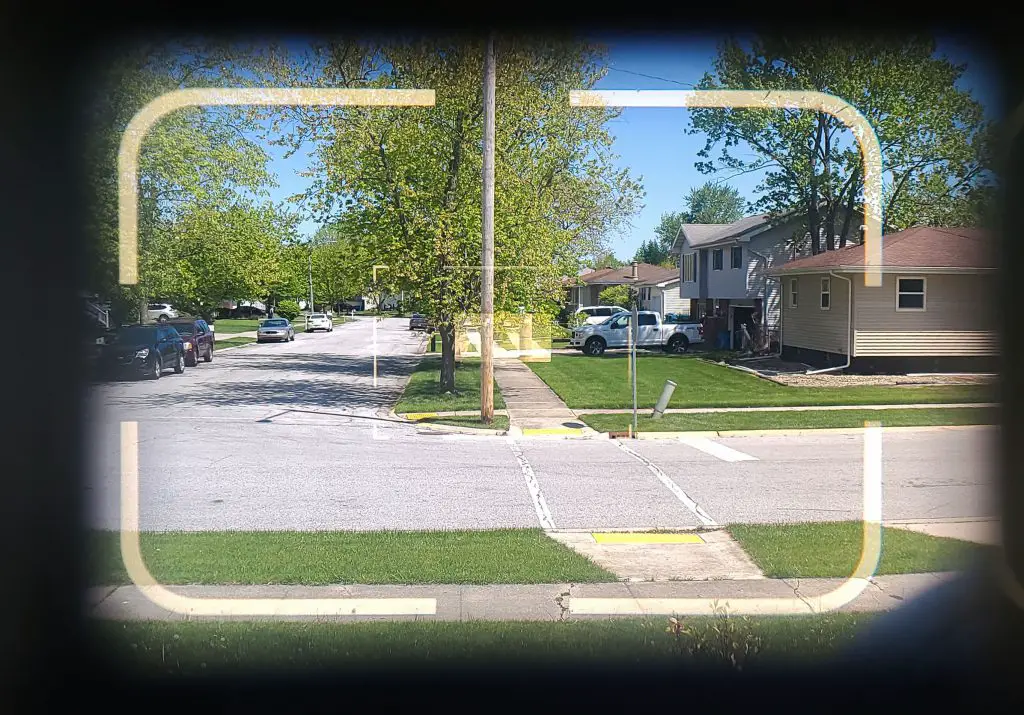
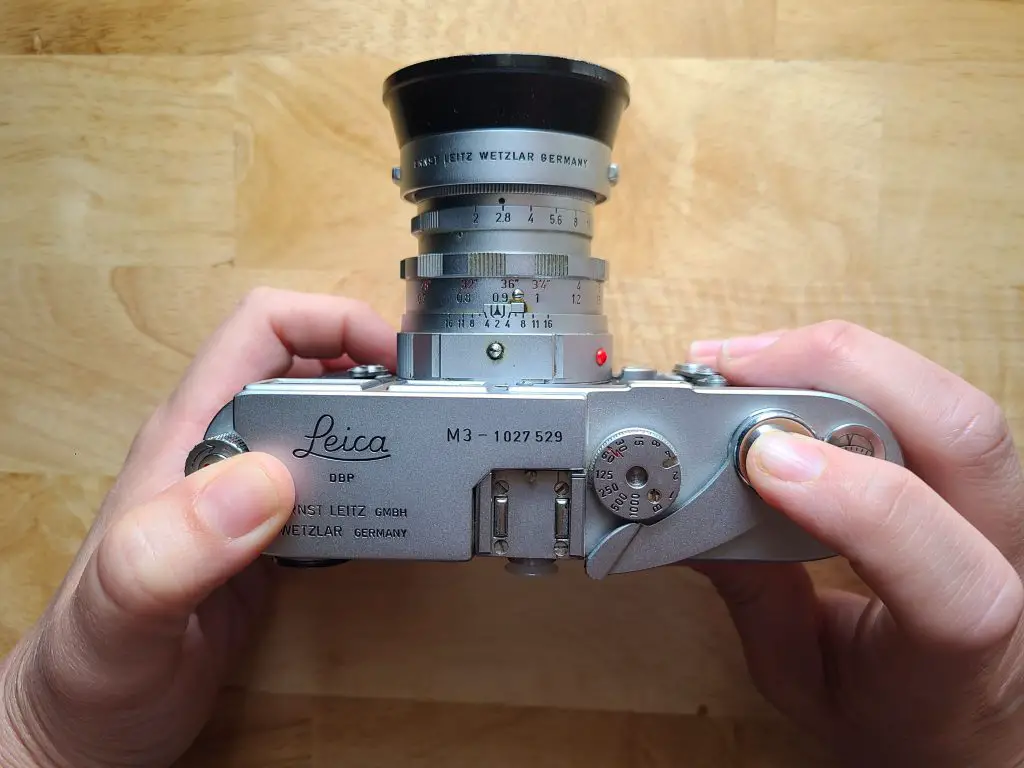
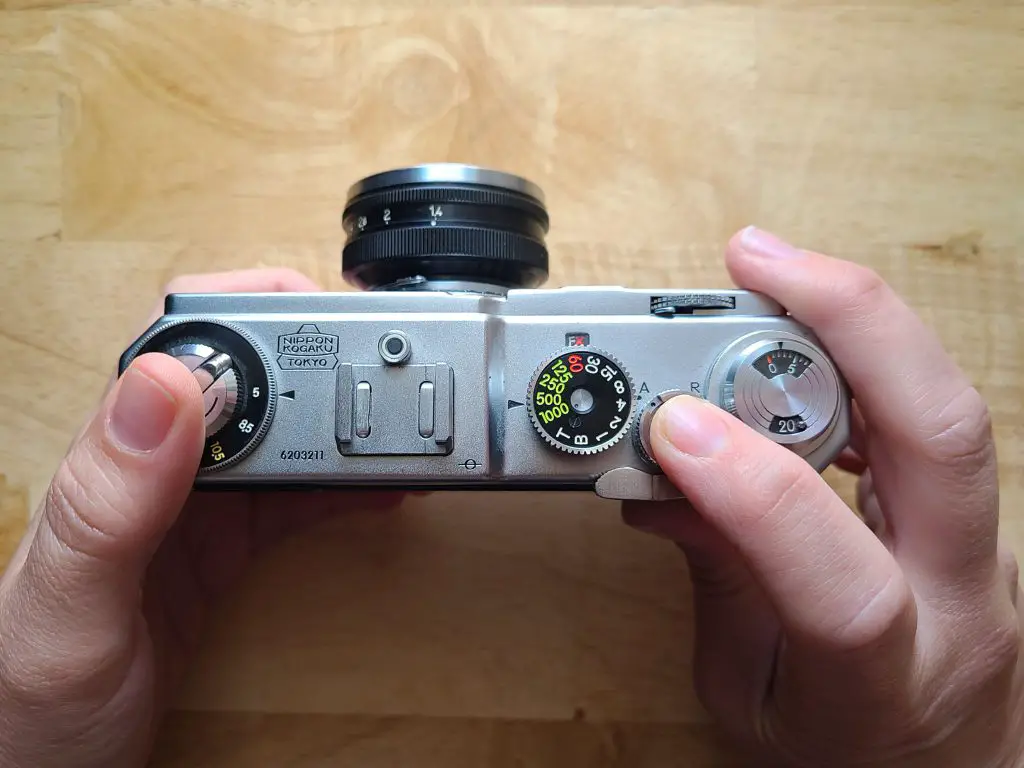








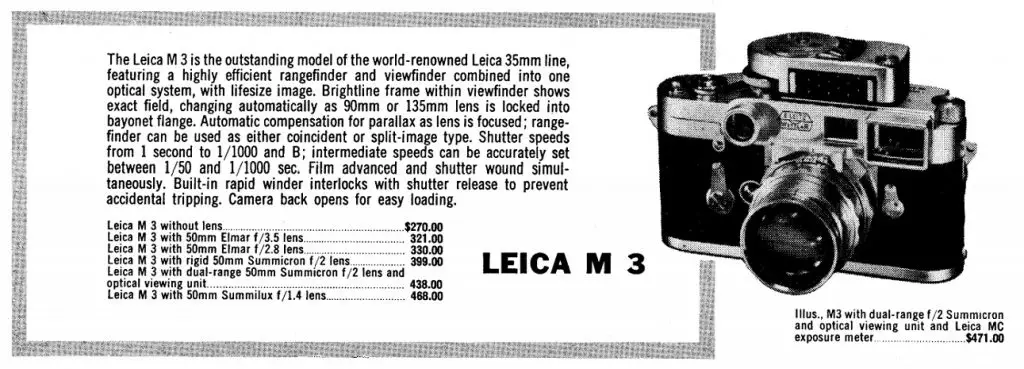
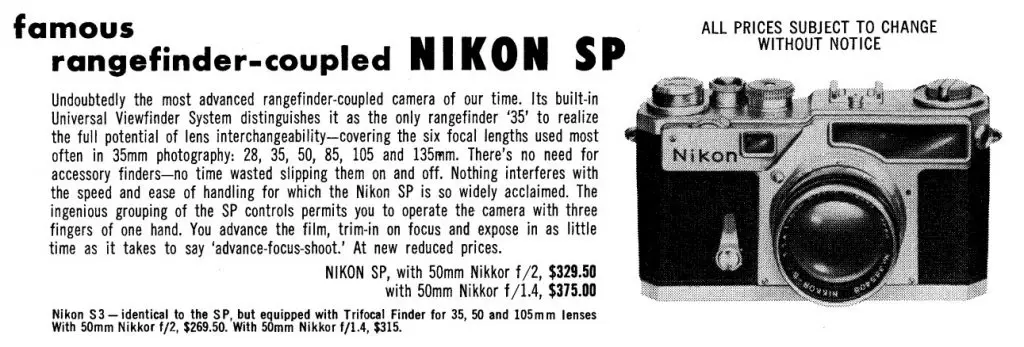
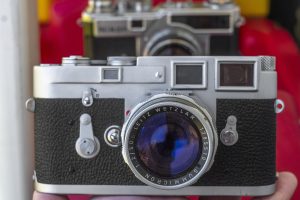
In the 1970’s the SP was much cheaper and I reluctantly acquired one instead of a Leica. When I was finally able to compare the two I realized the SP was far more user- friendly for my work (low light music- using the 85) though it lacks the M3 ‘feel. SP for me
Excellent post as always, Mike. Lots of emotions pop up whenever classic cameras (classic anything actually) get discussed and compared. One size, and in this case, one system rarely fits all. I personally have no experience shooting with the Nikon or that model Leica. The rangefinder that I use and enjoy the most is my Nicca 3-S. If fact, every Nicca in my collection is my favorite ;-). I had my 3-S serviced by Mr. Ye quite a few years ago and he’s recently serviced my IIIg (haven’t used that one yet). I guess the 3-S with it’s Nikkor lens has some connection to your Nikon so I’ll give you that. The IIIg does excite me as it is the final and best IMO of the Leica LTM bodies and the small improvements Leica made are evident when you look through the rangefinder/viewfinder. I’m looking to compare my 3-S against the IIIg as that be a close fight. Chris
Thanks for the comments Chris! I too, am a big Nicca fan, and love my Tower 45. I also have here a Nicca IIIL that works, although has rough cosmetics. Perhaps I should expand on the 35mm rangefinder comparison and include these!
It’s a never ending (but fun) rabbit hole whenever you compare one camera against another. I think you’ve done a very fair and balanced review of these two system cameras and if someone presented me with either one I’d take it in a heartbeat! They are most excellent choices. Chris
It’s actually not true you need external viewfinder for all wide angles on an M3; the Summicron and Summaron 35s were available in a goggled version, which lowers the magnification so the 50 frames now match the 35 field of view. Not ideal, but it’s the way the M3 system was launched.
You’re right, the goggles do change the main viewfinder for the wide angle lens, but I guess if you have to physically attach some kind of accessory to a camera, whether it’s goggles or an auxiliary viewfinder, it can’t be considered “in body”.
Mike, Björn beat me too it regarding using spectacle or goggle equipped lenses on the M3. But I was going to relate my comment to the fact that you didn’t have to trade in an M3 for an M2 just to shoot a 35mm lens. I used a f3.5 Summaron and it was no more difficult changing this lens than any other as normally you’d keep the goggles and lens attached together as one unit. Yes the v/f magnification was reduced, but going the other way my goggles equipped Tele-Elmarit magnified the v/f image but, boy, is that combo heavy!
I enjoyed this article, especially relating to the SP, of which I have no experience.
My interest in one of these Contax inspired Nikon rangefinders was shortlived. As a Contax user, I had imagined my Zeiss lenses would be compatible, and thus give me a more modern body in the Nikon. The fact that the lenses were incompatible soon put paid to that idea!
One, final comment, concerns the lens mounts used. As a user of both mounts I can assure you that the Leica bayonet is the easier of the two, especially with gloved hands. Trying to reach the spring retainer in the Contax/Nikon copy can be a pain in cold weather where invariably I needed to remove a glove to get at it. On the other hand, I preferred the focusing wheel used in the Contax and Nikon when using a 50mm lens,
Great review, and fun to read. It interested me because I own, and use both of these cameras. I purchased the my M3 about eight years ago when it was still possible to find examples of the camera (in rough, well used condition) in the $500.00 range. I found an example of the SP, also in the rough and well used condition, about 2 years ago and purchased if for about the same money. Both are great cameras and fun to use, but I, too would recommend the M3. If for no other reason than the quality/contrast of the M3 rangefinder patch is far superior to the SP. While my M3 rangefinder was far out of alignment and had to be sent off for adjustment, the contrast was still excellent even after all those years of use/abuse. In the case of the SP, the rangefinder had stayed in perfect alignment, but the contrast was so poor as to make proper focus nearly impossible except under the brightest, highest contrast lighting conditions. I was able to correct this condition, somewhat, by placing clear, blue plastic film in front of the VF window of the SP, but it is still nowhere near the quality of the M3. It is my understanding that there is not really much that can be done, even by qualified individuals, to restore the contrast of the SP rangefinder once it has faded. If I am wrong on this, I would love to know. I think it is worth a mention because the rangefinder fade could be a problem associated with even the prettiest, highest priced examples of the SP.
I really liked the “experiment” with regards to how your wife’s hands naturally fall on each camera body. And all your comparisons seem fair and correct based on my internet understanding of both these cameras.
A couple thoughts that I had are:
–The M3 didn’t have a motor drive option but Leica has been building trigger winder accessories since the LTM days. Later, Leica built motors for subsequent M’s but for the most part, their Leicavit better embodies the simple/manual/reliable/discreet philosophy of Leica rangefinder design. Not quite the same as a motor but an important, comparable accessory. I use a trigger winder for my Voigtlander but have yet to pony up the money for a Leicavit. And I must say, I greatly prefer a manual, quiet, no battery winder to a machine gun motor.
–Did the Nikon have an accessory light meter? Leica did and I’m sure they were fine in the 50’s but today, few have held up. The Leica was nice because it coupled to the shutter dial, so, when working, it would be faster to use than a handheld or other brand clip-on meter. Nikon may have had this too.
–You know that it’s impossible for me to have a conversation about any rangefinders without EBL! According to my notes, the SP has a baselength of only 58mm or 60mm (depending on the source) whereas the M3 boasts 68.5mm. The SP has a 1x magnification finder, which many people like because it can be operated with both eyes open. The Leica only has a .91x finder which is arguably not quite enough to comfortably shoot with both eyes open but in operation, the difference is slight. And this still results in a greater effective baselength anyway. So the Leica M3 is mathematically more accurate at focusing longer/faster lenses than the Nikon. This may also come with it more maintenance though and isn’t a concern with wider/slower lenses.
–Speaking of the rangefinder itself, I wonder how natural it is to place ones hands securely around each camera and keep ones fingers out of the way of the rangefinder and viewfinder windows on each body while focusing/operating the camera. Or winding the camera for that matter.
–And my final question is, where can I purchase a Mike Eckman voodoo doll? 😉
Cool review, I’ll be interested in a follow-up once your M3 is 100% functional!
Thanks for the detailed comment Johnny, glad you liked the comparo!
To answer your questions, yes, the SP had an accessory light meter that coupled to the shutter speed dial, the same way as the Leica’s. Although it was never put into production, a prototype Nikon SPX was also in the works and exists in prototype form that added an in body TTL meter that measured light at the film plane, just like the Leica/Minolta CL. The SPX prototypes were from 1962 and had it been put into production, would have been the only 35mm rangefinder with TTL metering at the time.
As for EBL, in an early draft of this article, I actually started talking about the Leica’s superior base length, but I omitted it as it was getting too technical, and I felt I was already hitting the point home that I preferred the Leica’s viewfinder and that it’s rangefinder is the best ever made. Personally, I’ve never had an issue with my hand blocking the rangefinder window of the Nikon. This was one thing that Nippon Kogaku improved upon the pre-war Contax which it was inspired by. It’s a much bigger problem on those cameras and the Soviet Kievs.
Finally, as for the voodoo doll, stay tuned for the Mike Eckman dot Com online store! 🙂
Sorry to nit pick, Mike, but the SP took its design clues from the post-war Contax IIa, not the pre-war Contax II. Looking at the front of a Contax II, IIa and SP, it will become immediately apparent that the IIa and SP are cousins in that the relationship of the viewfinder and rangefinder windows relative to the focusing wheel are the same. In the much larger Contax II, the rangefinder window is very near the right hand end of the body, with the serrated focusing wheel positioned “inside” and closer to the lens mount. In the IIa and SP the relative positions of the rangefinder window and focusing wheel are reversed. This very much helps with avoiding a finger blocking the rangefinder window, which you noticed with the SP.
With the Contax II/III models and the later Kiev clones, I did sometimes find a finger falling over the rangefinder window as a finger stretches for the focusing wheel. To mitigate this problem, it is easier to use the forefinger for the shutter release and the middle finger for focusing, although it isn’t a complete solution. Those two pinkies left and whose job it is to support the camera have other ideas! This works best with 50mm lenses, rather than the wide angles and tele lenses, due to the additonal friction that the latter lenses can impose because of the more complicated mechanism used to couple with the bayonet mount, and that they still rely on a conventional greased helicoid mount for focusing.
Of course Nikon and Contax rangefinders will forever be linked due to the almost identical lens mount and similar cosmetics, I do not agree that any design decisions for any Nikon rangefinder had anything to do with the post war Contax IIa and IIIa. The easiest way to prove this is that the Contax IIa and IIIas didn’t hit the market until 1950 and 1951, whereas the original Nikon was released in 1948 and by then, the shorter rangefinder base was already part of the camera’s design. Further disproving this point is that in interviews between Bob Rotoloni and Masahiko Fuketa, the designer of the SP and F, Fuketa stated that when work began on the earliest Nikon rangefinder prototypes, they took equal inspiration from both the Contax and Leica rangefinders so it can be extrapolated that the shorter rangefinder base was actually more of a Leica inspiration, rather than Zeiss.
As for the SP specifically, work for it began in 1955, immediately after the release of the Nikon S2, and by then Nippon Kogaku already saw the writing on the wall for the professional rangefinder and wanted to start work on an SLR. At that time, Nippon Kogaku was still a very small company and it didn’t have the financial or physical resources to keep advancing their rangefinders while building an all new SLR, so the bean counters at NK insisted that any new SLR share as many parts as possible with the SP.
Aside from the mirror box and pentaprism, what would eventually become the Nikon F and the SP share nearly 90% of parts. The shutter is the same, the motor drive coupling is the same, even the shutter speed dial and film advance lever are the same. If there was one camera that the Nikon SP took some cues from, it would be the Nikon F, not the Contax IIa or IIIa.
Slapped wrists and a bit of flaggelation!
I believe it is fair to compare the Leica M3 with the Nikon SP. They were contemporaries marketed to the same class of professional and serious amateur buyers. Both offered the best and most elaborate RF cameras possible for their times.
However, I feel that your review consists of a considerable amount of cherry-picking specific features which skews your results. I am not sure that I disagree with your conclusions, but I would like to do my own analysis using my own pick of features and see how my thoughts compare.
Lens selection: Here is an area that I feel you are way off. The Nikon SP was effectively out-of-production by the early 1960s. To compare the optics available for the ’S’ mount then with what is available for the M mount today is hardly fair. Since the expiring of the M mount patent rights, several manufacturers have produced optics in the M mount. This was not possible in the M3 era. I would prefer to compare what was available in 1957 for both cameras.
In 1957, the year the Nikon SP was introduced, Leitz offered a limited range of RF lenses. Ignoring the Visoflex optics, you could buy a total of six different focal length/aperture combos over four focal lengths: A modest aperture f3.5 Summaron, 50mm Elmar and Summicron, the 90mm Elmar f4 or the 135mm f4.5 Hektor. Hardly an earth-shattering selection. All beautifully-built and finished, excellent lenses, but I would only describe the 50m Summicron as actually outstanding in performance. In addition the regular Summicron only focused down to 3 1/2 feet.
In 1957, Nippon Kogaku offered a total of 14 different lenses ranging from 25mm to 135mm over eight focal lengths. These included lenses with maximum apertures of f1.8 for 35mm. f1.1 for 50mm, 1.5 for 85. It included the first Micro-Nikkor and even a Stereo-Nikkor set. All the normals and the wide angles focused down to three feet. By 1961, the Nikkor range had extended to 21mm with a total of 16 lenses available. And most of these lenses were excellent, well-finished and capable of producing results on a par with the Leitz optics.
Earlier Leitz lens coatings were softer and tend to easily scratch. They also used a helicoid grease than can vaporize, fogging internal lens surfaces. Nikkors by the mid-Fifties featured hard coatings that are difficult to scratch, and, in my experience almost never fog.
Leitz lenses featured double helicoids that allow parallel movement of the lens tube keeping the index markings and settings on top. RF Nikkors all came with rotating barrels except the external mount 50mm f1.1. Not as nice.
Leitz lenses definitely have a different color and contrast feel to them. It’s a rendering that some photographers prefer, and others could care less. Opinions vary.
Now, times did change. By 1964, the Leitz RF-mount selection would increase to 12 and include a 21mm lens and both 35mm and 50mm lenses with maximum apertures of 1.4.Total focal length/aperture combos would reach 14 by 1970, but by then the Nikon SP was more a matter of historical curiosity than a competitor and the M3 gone as well. So, if we are awarding points based on contemporary offerings, they would have to go to the Nikon.
You make a big deal about the dual-range Summicron, but to use the dual-range function, you have to have the snap-on googles, and then you only get down to 21 inches. The Nikon close-up device was available for any and either f2 or f1.4, did not require a special version of the lens and will get you down to 18 inches. Another point for Nikon
The lens mount: a lot of 35mm camera manufacturers went with built-in focusing mounts for normal lenses, including the Voigtländer Prominent, the Foton, and the Contax. While one may give reasons for following that design route, I do not buy it. Here is one area where the M mount is superior. I don’t care for the short turn of the bayonet, but it is simple, straight-forward and with the raised red-dot matched to the latch, easy to work with. Yes, the Contax/Nikon mount is a quick-turn bayonet, but you have to return the focusing helicoid to infinity before mounting an external bayonet lens—one extra step that slows the process. One point for the M3.
The M3 in 1954 was a mix of the revolutionary and German insistence on following traditional design. The rapid advance, auto-indexing of lenses and the viewfinder/rangefinder combo was a definite improvement. But the rewind knob represented the past, as does the drop-on-the-ground, separate takeup spool and the requirement for a long film lead to get through the fixed back—although the lift-up window helps. It would not be until the M4 that Leitz finally solved some of these design foibles. A Leica M4 is fairly easy to load and the rewind crank works great.
The SP does have a removable back, but this has its points too. And if you’re outside, just hook the back on its edge into the body groove. And a rewind crank? How novel. Strange, but isn’t that what every 35mm camera uses now unless it has a motor to sub?
Points to Nikon.
Designing the most effective rangefinder/viewfinder involves a series of trade-offs. It is impossible to ‘see’ the entire coverage of a 50mm lens on 24x35 without moving one’s eye around. It is even harder to do with a 35mm wide angle. The M3 uses a slight reduction to give a near-life-size view. The SP view is life-size, but the bright frame covers slightly less than full frame (they don’t tell you that in the advertising).The M3 viewfinder is bright, clear. The frame lines easy to see and remain bright even in low light. However, the tiny135mm frames tend to get lost in the over all view. The SP viewfinder is not quite as bright, but turning the frame line selector not only brings in new frames but causes the other frame lines to converge, making the longer lens frames easy to see and follow. The auxiliary finder for the 35.28mm lenses is okay. At least it’s there and more convenient than the googles required for the Summaron. I would grant a tie.
Which brings us to the rangefinder. The M3 RF patch is bright, large and shows as a sharp-edged rectangle. It is, in my experience the easiest RF patch to use of any 35mm coincident RF. The ability to edge-focus is a particularly strong feature. The SP’s RF patch, by contrast, is fuzzy-edged and simply not as bright. In many samples today, the patch is faded and difficult to use. Too bad since it was a good RF otherwise. Point to Leica.
Ergonomics is one area where I feel your review was particularly unfair. No experienced Nikon RF user would ever pick up or try to shoot a Nikon camera the way you show in your pictures. As the Nikon ads stated, it’s ‘one-two-three shoot.’ Thumb on the rapid advance, index on the release and middle finder on the focus wheel. Not a problem. You don’t like the focus wheel? Well, then you have a personal problem, because focusing the normal or wide angle lenses is what it is there for. And you will have your left hand free.
Details, details: The short-throw, ratcheted advance lever on Nikon RF and F cameras is a delight to use. It allows the user to advance the film without having to displace one’s shooting finger, allowing rapid shooting. Too bad the Leica has a longer throw—although better than a Leicaflex.
I personally prefer the external socket for a cable release. It is more secure. Having broken off more than my share of PC cable releases, I appreciate Nikon’s sticking with external release as long as they did.
And what happened to T? A nice setting when setting up lenses for macro work, missing a cable release or cleaning around the shutter. The Nikon shutter speed dial is particularly nice. Turn it in any direction 360. Colors on black are easier to read, and the larger, higher dial is easier to turn.
Oh, and flash sync. Nikon has one socket—a PC plug set inside a locking socket—on the left front where plugging in is closer to a flash unit. The Leica gives you two sockets on the back to poke you in the eye if you’re left-eyed as I am. And what kind of socket is it? Not PC, but proprietary. Want to use a non-Leica flash gun? You better find an adapter. Point to Nikon.
Leica X sync is 1/50th of a sec. Nikon is 1/60th and does not require a separate mark.
Both the SP and the M3 are capable of mounting a light meter that couples to the shutter speed dial. The Nikon unit, probably made by Sekonic, slips on from the front and locks on with a spring clip. Push it to the left against a spring, line up the selected shutter speed and you’re good to go. The Leitz meter also couples to the shutter speed dial and when in place gives you a nice, bigger wheel to turn when selecting the speed, but getting the meter on or off requires carefully lining the lug with the dial slot and even then it can be uncooperative. I have seen Leicas with damaged or scratched shoes resulting from too hasty attempts to mount or dismount that meter.
A final comment: You mention the illuminator and bulk backs. Why bother? The illuminator was hardly a big deal in its day, does not work very well and saw few sales. Most ended up with leaky batteries. As for bulk backs: Never happened for the SP. One, maybe two prototypes exist. On the other hand, the motor drive was a big thing, and a major factor in the Nikon F’s success. Leica offered a motored M4, but never really did much with electric motors.
So, how do I score?
If I was ranking strictly on the basis of what these cameras were capable of in 1957 or 1959, I would have to give the reward to the Nikon SP based on available optics and the motor drive. If the Leica would have had the same lenses it offered in 1969 available ten years earlier, the palm would go to the Leica based on its superior rangefinder. But the biggest factor remains how does the camera feel in hand. And that is an individual preference that no amount of writing can prove one way or another.
There is, of course, an alternmative way of comparing the two cameras:
Backwards compatibility of camera own brand lenses – Leica 1 Nikon 0.
Future compatibility of camera brand lenses – Leica 1 Nikon 0.
Availability of some other, excellent, non- camera brand lenses, older and modern, Leica 1 Nikon 0.
A system camera Leica 1 Nikon 0.
Wes, you make some excellent, and well worded counterpoints. To be honest, I can’t shoot any holes in anything you’ve said. My only comment was that in regards to lens selection, you’re right in that only considering what was available during the period of time these two models were current, the Nikon SP’s selection was very robust and had options the Leica didn’t. The Leica M3’s lens selection only got as great as it did with continued development of new lenses. Had I written this review as a sort of buyer’s guide of the two in 1964, my opinions definitely would have changed, but I wrote this from the perspective of a collector in 2021, and there are simply far more options in the Leica M-mount today.
Also, in regards to cherry picking which characteristics I compared the two cameras against, I never hid the fact that I was rating the cameras based on what’s important to me. This is my blog, after all! 🙂
That said, I definitely do value your input, and like I said a couple times in the review, I still REALLY like the SP. I think it’s the more interesting of the two and prettier to look at. I still shoot my S2 on a regular basis and although I do not own an SP in my permanent collection, if I did, it would definitely not gather dust! 🙂
Mike, I love this column. I’ve owned 4 M3s (both double-stroke and single-stroke) and a Nikon S2, and I just bought an SP. I also own a Kiev from the 1950s, and a Contax IIa. The DS M3 is the best, smoothest, and most refined camera I’ve ever used, but as you say, this is mostly subjective. The best solution? Buy both, of course!